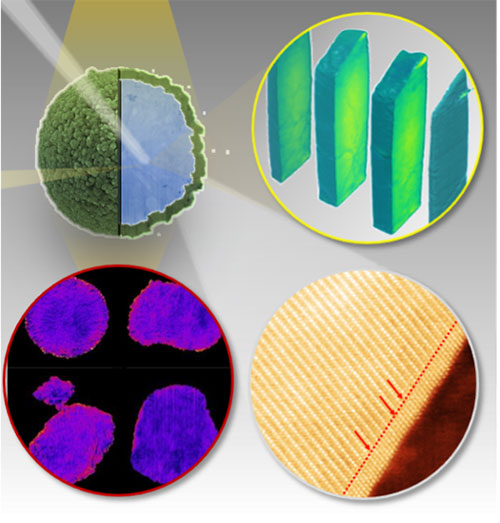A Graded Route to Constructing Stable Batteries
July 30, 2021
 enlarge
enlarge
Illustration showing how multimodal x-ray- and electron-based imaging and spectroscopy measurements reveal different aspects of the structure and composition of the valence-gradient nickel-rich battery cathodes.
What is the scientific achievement?
A team led by Brookhaven Lab scientists discovered a new way to stabilize high-nickel-content battery cathodes to improve their long-term performance. These materials are attractive for their high storage capacity but suffer cracking upon charge/discharge cycling. Here, the cathode was purposefully designed to have a nickel oxidation state that gradually changed from the surface to the interior. The cathode retained 88 percent of its storage capacity after 100 cycles, compared to 70 percent in a control material.
Why does this achievement matter?
Because of their high energy density, high-nickel-content cathodes have potential to power electric vehicles over much longer distances than supported by current batteries. This study demonstrates the utility of nickel valence gradients for mitigating the poor cyclability of these materials.
What are the details?
High-nickel-content cathodes have captured the attention of scientists for their high capacity, a chemical property that could power electric vehicles (EVs) over much longer distances than current batteries support. Unfortunately, the high nickel content also causes these cathode materials to degrade more quickly, creating cracks and instability problems as the battery cycles. In search of solutions to these structural problems, scientists have synthesized materials made with a nickel concentration gradient, in which the concentration of nickel gradually changes from the surface of the material to its center, or its bulk. These materials have exhibited enhanced stability, but scientists have not been able to determine if the concentration gradient alone was responsible for the improvements. The concentration gradient has traditionally been inseparable from another effect called the valence gradient, or a gradual change in nickel’s oxidation state from the surface of the material to the bulk.
In this study, a team of researchers led by the U.S. Department of Energy’s (DOE) Brookhaven National Laboratory synthesized a unique material that isolated the valence gradient from the concentration gradient. Once the material was synthesized, the team used the Hard X-ray Nanoprobe (HXN) and Full Field X-ray Imaging (FXI) beamlines of the National Synchrotron Light Source II (NSLS-II) at Brookhaven Lab for characterization. In addition to their studies on these two beamlines, the team also used the Electron Microscopy Facility at the Center for Functional Nanomaterials (CFN) at Brookhaven. By combining the capabilities of NSLS-II and CFN, the researchers were able to visualize the atomic-scale structure and chemical makeup of their sample in 3-D after the battery operated over multiple cycles. The team carried out additional characterization experiments at the Advanced Light Source (ALS) at DOE’s Lawrence Berkeley National Laboratory and the Advanced Photon Source (APS) at DOE’s Argonne National Laboratory. Their findings demonstrated that the valence gradient can serve as a new approach to stabilize the structure of high-nickel-content cathodes against degradation and safety issues.
CFN Capabilities
The CFN Electron Microscopy Facility was used to visualize the atomic-scale structure and chemical makeup of the cathode. X-ray instruments at NSLS-II, APS, and ALS were used in this multimodal investigation.
Publication Reference
R. Lin, SM. Bak, Y. Shin, R. Zhang, C. Wang, K. Kisslinger, M. Ge, X. Huang, Z. Shadike, A. Pattammattel, H. Yan, Y. Chu, J. Wu, W. Yang, M. S. Whittingham, H. L. Xin, X.-Q. Yang. “Hierarchical nickel valence gradient stabilizes high-nickel content layered cathode materials”, Nature Communications 12, 2350 (2021).
DOI: https://doi.org/10.1038/s41467-021-22635-w
Brookhaven Lab press release: “Scientists Discover New Approach to Stabilize Cathode Materials”
Acknowledgement of Support
Dr. Ruoqian Lin, Dr. Seongmin Bak, and Dr. Xiao-Qing Yang were supported by the Assistant Secretary for Energy Efficiency and Renewable Energy, Vehicle Technology Office of the U.S. Department of Energy through the Advanced Battery Materials Research (BMR) Program, including Battery500 Consortium under Contract DE-SC0012704. Work done by Dr. Chunyang Wang and Dr. Huolin Xin was supported by the U.S. Department of Energy’s Office of Energy Efficiency and Renewable Energy (EERE) under the Award Number: DE-EE0008444 and the startup funding of Huolin Xin. Mr. Rui Zhang was supported by the startup funding of Huolin Xin. Dr. Y. Shin was supported by the Office of Vehicle Technologies of the U. S. Department of Energy under contract number DE-AC02-06CH11357. Dr. S. Whittingham is supported by the Assistant Secretary for Energy Efficiency and Renewable Energy, Vehicle Technology Office of the U.S. DOE through the Advanced Battery Materials Research (BMR) Program, including Battery500 Consortium under contract No. DE-EE0007765. This research used resources of the Center for Functional Nanomaterials, which is a U.S. DOE Office of Science Facility, and the Scientific Data and Computing Center, a component of the Computational Science Initiative, at Brookhaven National Laboratory under Contract No. DE-SC0012704. This research used resources 3-ID, 18-ID, and 28-ID-2 of the National Synchrotron Light Source II, a U.S. Department of Energy (DOE) Office of Science User Facility operated for the DOE Office of Science by Brookhaven National Laboratory under Contract No. DE-SC0012704. Soft X-ray characterization was carried out at the Advanced Light Source (ALS), a US Department of Energy, Office of Science User Facility under Contract No. DE-AC02-05CH11231. The XRD experiments were carried out at Beamline 17-BM-B of the Advanced Photon Source (APS) which is supported by the U.S. Department of Energy, Office of Science, and Office of Basic Energy Science, under Contract No. DE-AC02-06CH11357.
2021-19101 | INT/EXT | Newsroom









